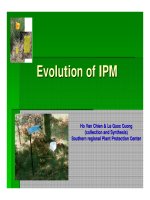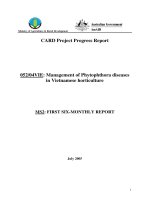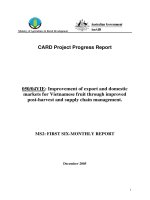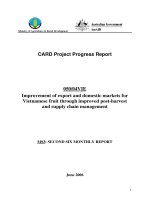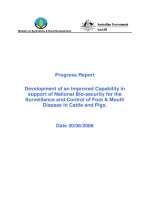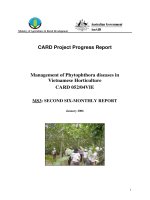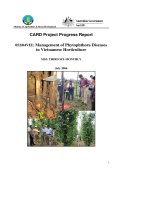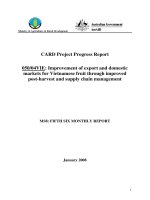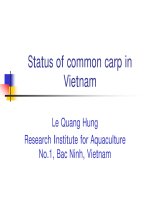Báo cáo nghiên cứu khoa học " Development of an Improved Capability in support of National Bio-security for the Surveillance and Control of Foot & Mouth Disease in Cattle and Pigs - Milestone 3 " pptx
Bạn đang xem bản rút gọn của tài liệu. Xem và tải ngay bản đầy đủ của tài liệu tại đây (155.15 KB, 23 trang )
Ministry of Agriculture & Rural Development
Technical Report
Development of an Improved Capability in support
of National Bio-security for the Surveillance and
Control of Foot & Mouth Disease in Cattle and Pigs.
Milestone 3
National Reference Laboratory and Regional
Laboratories operational and effective.
By
Chris Morrissy
Table of Contents
1.
Institute Information___________________________________________________ 3
2.
Project Abstract _______________________________________________________ 4
3.
Executive Summary ____________________________________________________ 4
4.
Introduction & Background _____________________________________________ 5
5.
National Reference Laboratory and Regional Laboratories operational and effective 6
5.1
5.2
Capacity Building _________________________________________________ 8
5.3
6.
Implementation Highlights _________________________________________ 6
Publicity _________________________________________________________ 8
Conclusion ___________________________________________________________ 9
7. Appendix_______________________________________________________10
7.1
7.2
7.3
Appendix 1 Standard coversheets, result sheets and IQC record keeping forms
eg FMD 3ABC ELISA:___________________________ 10
Appendix 2 FMD Serotyping Results for Vietnam 2005 – 2009_____ 14
Appendix 3
Sequencing information from project 2005 – 2009_____ 15
7.4 Appendix 4 FMD serosurveilance results_______________________ 24
1. Institute Information
Project Name
Vietnamese Institution
Regional Animal Health Centre, Ho Chi Minh
City (RAHO - 6 ), South Vietnam.
Vietnamese Project Team Leader
Dr. Dong Manh Hoa
Australian Organisation
Australian Personnel
Australian Animal Health Laboratory
(AAHL), PMB 24, Geelong, 3213,
Australia
Mr Chris Morrissy
Date commenced
01/06/2005
Completion date (original)
01/06/2008
Completion date (revised)
Reporting period
Contact Officer(s)
In Australia: Team Leader
Mr Chris Morrissy
Diagnostic Virologist
Supervisor Mammalian Virology
Organisation Australian Animal Health
Laboratory (AAHL), PMB 24,
Geelong, 3213,
Australia
Name:
Position:
Telephone:
Fax:
+61 3 5227 5000
+61 3 5227 5555
Email:
In Australia: Administrative contact
Mr Chris Morrissy
Name:
Patents Contracts Officer
Position:
Organisation Australian Animal Health
Laboratory (AAHL), PMB
24, Geelong, 3213,
Australia
In Vietnam
Telephone:
Fax:
Email:
Dr. Dong Manh Hoa
Name:
Director
Position:
Organisation Regional Animal Health Centre,
Ho Chi Minh City (RAHO - 6 ),
South Vietnam.
+61 3 5227 5000
+61 3 5227 5555
Telephone:
Fax:
Email:
+ 84 8 8568220
+ 84 8 8569050
2. Project Abstract
The project’s purpose was twofold - to develop capacity for FMD (and other disease)
surveillance and diagnosis at both a laboratory and field level, and to investigate the
serotypes of FMDV circulating in Vietnam and the reason for vaccine failures. Regional
laboratories were set up with the reagents and methods to allow a diagnostic capability for
FMDV diagnosis and serology. Control strategies for understanding of FMD epidemiology
have been implemented through veterinary and laboratory training workshops. The project
has highlighted the importance of having a laboratory network to identify what is happening
in the field and how to prevent and control disease outbreaks. The pilot zones were
established in provinces near the borders of Vietnam to study serotypes circulating in
Vietnam and to determine their origin. The number and quality of samples increased with
each round of the project giving more data on the FMD situation in Vietnam. Virus isolation
and molecular studies can now be carried out on FMD samples from the field and molecular
epidemiological studies of the FMDV isolates in these provinces has provided insights into
the effectiveness of border control and origin of circulating FMDV. Improved diagnostic
capacity for FMD allows for the early detection and identification of disease enabling better
control of disease and helps reduce loss of livestock and therefore increases productivity.
3. Executive Summary
Over the life of the project there was improvement and advances in both activities in the field
and laboratory. The quality of both the diagnostic tests and the field data collected continued
to improve throughout the project.
Throughout the project, consultants from AAHL worked with four diagnostic laboratories –
RAHO – 6 - HCMC, NCVD - Hanoi, RAHO – 7 - Can Tho and RAHO – 4 - Da Nang - to
improve FMD diagnostics and monitor the progress of the project. The RAHO - 6 and
NCVD laboratories now have virus isolation, virus neutralisation test, ELISA, PCR and
sequencing techniques established for FMD diagnosis. The project also worked with
NAVETCO research laboratory to establish the capability for FMD serology by ELISA.
RAHO - 6 is now well established in all these techniques and both RAHO - 6 and NCVD
laboratories are also applying the new technologies to other disease problems in Vietnam eg
RAHO – 6 have used virus isolation for Goat Pox, PRRS and CSF, NCVD used virus
isolation to identify a new isolate of PRRS in Vietnam. The Can Tho and Da Nang
laboratories have the capability for FMD diagnosis for serotyping and post-vaccination
serology by LP - ELISA.
In addition, RAHO - 6 have learnt techniques in reagent production and have produced their
own FMD antigen. In developing such techniques they have also gained the ability to
trouble-shoot the ELISAs and problems with growth of FMDV. Staff from RAHO - 6 and
NCVD also visited AAHL during each year of the project for training and collaborative
projects.
In regards to field activities, there were significant improvements in the quality and number
of samples submitted to the laboratory for serosurveillance and serotyping for ELISA. The
latter allowed DAH to better understand and identify the circulating serotypes of FMD
viruses in Vietnam in addition to gaining confidence in conducting large serosurveillance
surveys. There was also a significant improvement in the amount of data collected over each
round of the project. RAHO - 6 now has an epidemiological unit and this project has
assisted in developing the skills of the epidemiologists in serosurveillance, outbreak control
and investigation of vaccine failure.
Information from the serosurveillance in the project was reviewed to give an indication on
the success of vaccination and the prevalence of FMD infection. This data has been presented
at the OIE/SEAFMD regional meetings and to DAH.
The project was invited to a number of regional meetings to present data from Vietnam on
control of FMD. As a result of these outputs of the project, Vietnam has been used as an
example for others in the region to show the type of information that can be collected on
serosurveillance and outbreak investigation. The project coordinated activities with the
AusAID capacity building project to allow both projects to achieve their objectives, eg
combined PCR and sequence training with sequencing FMD isolates along with AI, PRRS
and CSF isolates from Vietnam.
Outbreaks of avian Influenza (AI) and PRRS had impact on both field and laboratory
activities of this project with DAH staff being overloaded with work.
4. Introduction & Background
Objectives of the project:
1. To establish an effective laboratory network for the diagnosis and control of FMD
by the provision of resources and training of staff in required methods and quality
assurance.
2. To provide accurate data to explain failure of vaccination to control FMDV and to
develop new effective vaccine application strategies.
Completing these objectives will improve the diagnostic capability of the veterinary
laboratories in Vietnam and the training of DAH veterinarians in disease investigation
and control. This will strengthen the profile of DAH which will play a vital role in
making Vietnam more economically competitive. Improved animal health will lead to
an increase in rural productivity though increased animal production and indirectly in
increased crop production. Healthy animals will enable small farmers to be more
competitive in the local market. Control of FMD and animal diseases in general will
give poor farmers a more stable income stream and reduce their vulnerability to natural
and economic problems. Establishing a diagnostic network which extends from the
North to South Vietnam, from the laboratory to the farm level, reinforced by training
and education, will give Vietnam a working model on which to base disease control.
This will directly increase the competitiveness and productivity of the national
agricultural system which includes the major areas of concern including the Mekong
Delta and the Central Coast.
Specific Objectives for the Laboratories:
•
•
•
•
•
Laboratory training manuals incorporating diagnostic techniques
Functional tests at RAHO – 6 –HCMC and NCVD - Hanoi laboratories to allow
it to operate as national reference laboratories.
Functional ELISA tests at RAHO – 4 - Da Nang, RAHO – 7 - Can Tho &
NAVETCO laboratories to allow them to operate as regional laboratories
Protocol manuals for submission and handling of samples and provision of
feedback of results
Laboratory Quality Control procedures documented and tested. Internal Quality
control results documented and reviewed for each laboratory.
Implementation Approach and Strategy
The approach for technology transfer is well established at AAHL and has been
successfully applied in previous projects in Vietnam, Thailand and Indonesia. The
project approach used was also thought to be the most appropriate for developing an
understanding of FMD epidemiology in Vietnam. The field studies and serosurveillance
approaches were designed and planned in conjunction with DAH to provide the
maximum necessary information to demonstrate the FMD situation in Vietnam and the
effectiveness of FMD vaccines. The diagnostic technologies that will be used in this
approach are the standard diagnostic tests in use throughout the world to study FMD as
directed by OIE.
AAHL has a lot of experience with field surveys for prevalence of antibodies, as in the
ACIAR projects in Laos and Thailand on FMD. The Philippines is another example
where OIE standard diagnostic tests are being used to control and eradicate FMD.
5. National Reference Laboratories and Regional Laboratories
operational and effective.
5.1 Implementation Highlights
The main achievements of the project were:
•
The following FMD diagnostics were established in the collaborating laboratories:
RAHO - 6 and NCVD laboratories have established virus isolation, virus
neutralisation test, ELISA for antigen and antibody detection, PCR and
sequencing
RAHO – 4 and RAHO – 7 laboratories have the capability for FMD diagnosis
for serotyping by ELISA (detection of antigen) from a FMD outbreak and
serology by ELISA for post-vaccination surveillance.
•
A quality system was implemented in each laboratory for FMD diagnostics which
included standardised methods, IQC and better record keeping.
Standardised methods introduced for ELISAs, cell culture, PCR, sequencing
and data collection ( eg ELISA methods attached to this email with this report )
Standard coversheets, result sheets and IQC record keeping forms ( eg ELISA
forms appendix 1 )
•
Increased collaboration between the laboratories since the inception of the project
•
Improvement in the quality and number of samples submitted to the laboratory for
serotyping by ELISA ( summary of serotyping results appendix 2 ) . This gave DAH a
better understanding of the circulating serotypes of FMD viruses in Vietnam. The
improvement in sample collection also allowed for virus isolation from field samples
that had not been possible prior to the project and in turn enabled sequence data to be
obtained from FMD virus isolates.
•
Sequencing, genotyping and analysis of approximately 100 Vietnamese FMD isolates
collected from 2006 onwards. The isolates were sequenced and analysed at AAHL by a
scientists from AAHL and RAHO – 6. The sequence data was then sent to WRL for
confirmation and comparison to other FMD isolates. This information was shared with
SEAFMD in support of the regional project to control FMD.
•
Sequencing/Genotyping 2006/2008
Serotype O: 3 topotypes
Cathay (33%), ME-SA (PanAsia) (6%) & SEA (Myanmar 98) (41%)
Pigs: mainly Cathay & SEA
Cattle: mainly SEA
Serotype A: Thailand/Malaysia 97
Vaccine used for FMD Serotype A needed to change from A 22 to
A Malaysia 97 (also antigen for serology)
Serotype Asia 1: Jiangsu-China-2005 (isolated from the Nth & Centre)
and Myanmar 98 (isolated from the Centre)
Confirmed 2 sources of Asia 1 virus into Vietnam
•
The analysis of FMD isolate sequence data from Vietnam was used to compare
sequences to FMD sequences from around the world and is shown in appendix 3
•
Improvement in the quality and number of serum samples submitted to the laboratory
for serology by ELISA. This gave DAH a better understanding of the animals exposed
to FMD and the vaccination coverage in Vietnam.
Two rounds of serosurvellance each year with first round collected prior to
vaccination and the second round collected after vaccination
The data form serosurvellance showed vaccine coverage and number of animals
exposed to FMD (eg summary table example attached to email)
Recommendations for improved serosurveillance can be found
•
A number of sera samples were retested to compare antibody titres for samples from
the provinces to allow identification by serology of the circulating isolate. The results
indicated that the combined use of the non-structural 3ABC ELISA and the structural
LP-ELISA could be used to identify the serotype of FMD that had been circulating in
the field (eg appendix 4 ).
•
Throughout the project AAHL consultants visited the laboratories to:
Establish FMD Elisas and standardised techniques
Validate an Elisa using antigen produced at RAHO – 6 using Vietnam isolates.
The production of FMD Elisa antigen allows the laboratories to be more selfsufficient and is the start of the laboratories capability to produce its own
reagants.
Establish and review cell culture and virus isolation for growth of FMD isolates
from the field. Cell culture is important to grow FMD virus to allow further
analysis of FMD field isolates by PCR and sequencing. Cell culture has also
been used for serology (VNT) and for isolation of other disease agents, such as
goat pox, CSF and PRRS.
Review molecular techniques and establish a workflow for sample processing
and testing to ensure quality results
Evaluate quality assurance records and data collection to ensure test records
were being maintained and results were being interpreted correctly.
Provided advice on field information required and produced data collection
form
Analyse field and laboratory results to provide epidemiological input
Supply consumables and reagents for testing of samples by FMD Elisa,
molecular technology and cell culture.
Train staff in biosafety techniques and assist with their implementation
Assess quality assurance procedures and provide input to quality assurance
manuals
Assess accurately of tests by Proficiency Testing. Samples supplied to
laboratories to test results produced were accurate
.
5.2 Capacity Building
The project has provided training and technology transfer of FMD diagnostics to each
laboratory involved in the project. Reagents and standard methods were supplied to each
laboratory giving them the diagnostic capability for FMDV diagnosis. Serology and
serotyping (detection of antigen) by Elisa is now being practiced at all of the laboratories and
RAHO – 6 and NCDV have also established virus isolation, cell culture, virus neutralisation
for serology, molecular and sequencing techniques.
Training and education of field veterinarians in sample and data collection showed an impact
with an increase in quality and numbers of samples collected and submitted to the laboratory.
These skills will be vital in implementation of the National FMD Control Program.
5.3 Publicity
The CARD AusAID project received publicity in Vietnam, Australia and internationally
through the training programs and also through the achievements in understanding FMD in
Vietnam. FMD is a disease of importance in Vietnam and the region and this put this project
into the lime light. The project has been publicised through a press releases in Australia and
articles in newsletters including the SEAFMD newsletter and on the internet. The results
from the project have been presented at:
o
o
o
o
OIE/SEAFMD meetings (eg presentation attached to email)
EU FMD 2008 (eg presentation attached to email)
WAVLD 2007, 2009
Lower and Upper Mekong Working Group meetings in the region.
With the laboratory and epidemiological capacity now available in the collaborating
laboratories, particularly RAHO – 6, there is now the potential for a smaller, more focused
study on vaccination failure. This would be best limited to a smaller number of provinces in
southern Vietnam, with a study protocol aimed specifically at investigating vaccination
effectiveness.
As the collaborating laboratories are now implementing a range of FMD diagnostic
techniques it is considered that these abilities will be sustained and transferred to other
laboratories.
6. Conclusion
The project achieved its objectives by helping to improve the FMD and general diagnostic
capacity of the network of veterinary laboratories. The RAHO – 6 and Hanoi laboratories
have provided and are continuing to provide support and training to other laboratories in the
network.
The project has highlighted the need for training of field veterinarians in the collection of
data and how to ensure the correct information is obtained from the farmer. The staff at
RAHO – 6 will continue to deal directly with the veterinarians in the field to ensure the
correct information is collected in future surveys.
The establishment of cell culture has allowed the growth of FMD isolates from the field that
could not be previously identified at RAHO - 6 and at NCVD. The increased FMD diagnostic
capacity, combination of ELISA, PCR and cell culture for detection of FMD, has increased
the number of FMD outbreaks identified in Vietnam. The use of cell culture for growth of
FMDV has resulted in the availability of higher quality samples for sequencing. The
introduction of molecular techniques at RAHO – 6 has allowed sequencing results to be
obtained quickly and has allowed informed decisions to be made about serotypes of FMD
circulating in Vietnam and the correct vaccine to use in each region to control FMD. AAHL,
DAH and WRL have cooperated on analysis of the sequence data from Vietnam isolates.
Cell culture has also allowed the production of ELISA antigen which is a key reagent in
FMD diagnostics. RAHO – 6 is now producing own reagent which it has transferred to
NCVD, RAHO – 4 and RAHO – 7.
This project continues to be important for Vietnam with the repeated cyclical outbreaks of
FMD. The Vietnam Government and RAHO - 6 have invited AAHL to give advice on FMD
control and have used the project as a model for the implementation of their control plan.
Despite the overwhelming requirement for control and surveillance of AI and more recently
PRRS, the Vietnam Government is committed to the control of FMD. This is evidenced by
the currently active National FMD Control Program.
The project highlighted the need to have coordination between the laboratory and the field
staff in the control of FMD and in understanding the serosurveillance data post-vaccination
and post-exposure to FMD from the laboratory results. In the laboratory it is important to
have the correct reagents to match the circulating field virus ( also highlighting the
importance of improved FMDV identification ) and in the field the field data to allow the
interpretation of the laboratory results. The whole veterinary network is important in the
control of disease, there needs to be strong link between the field and laboratory to ensure
both the actions in the field and the results in the laboratory are correct.
This project set the standard for what was required for a laboratory network to function and
the lessons learnt were used in handling HPAI and PRRS outbreaks in Vietnam and the
projects and investigations that followed.
Appendix 1
Standard coversheets, result sheets and IQC record keeping forms eg FMD 3ABC
ELISA:
9.11
3ABC C-ELISA Test Coversheet.
FMD 3ABC COMPETITION ELISA
SAN:
SAMPLE IDENTIFICATION:
TEST (3ABC C-ELISA):
SUPERVISOR:
DATE PLATE COATED:
OPERATOR:
DATE OF TEST:
OPERATOR:
WASHING METHOD:
PLATE SHAKER:
INCUBATOR:
PIPETTERS:
NUMBER OF PLATES:
3ABC ANTIGEN DILUTION:
DETECTING ANTIBODY BATCH:
DETECTING ANTIBODY BATCH:
SERUM CONTROLS & SAMPLE DILUTIONS:
COATING BUFFER DATE:
BLOCKING BUFFER DATE:
CONJUGATE BATCH:
CONJUGATE DILUTION:
SUBSTRATE INCUBATION TIME:
Date Reported
Signed
9.12
Result page/Plate Format
ELISA PLATE FORMAT
1
S1
2
S1
3
S9
4
S9
5
S17
6
S17
7
S25
8
S25
9
S33
10
S33
11
12
A
C++
C++
B
S2
S2
S10
S10
S18
S18
S26
S26
S34
S34
C++
C++
C
S3
S3
S11
S11
S19
S19
S27
S27
S35
S35
C+
C+
D
S4
S4
S12
S12
S20
S20
S28
S28
S36
S36
C+
C+
E
S5
S5
S13
S13
S21
S21
S29
S29
S37
S37
C-
C-
F
S6
S6
S14
S14
S22
S22
S30
S30
S38
S38
G
S7
S7
S15
S15
S23
S23
S31
S31
S39
S39
S16
S16
S24
S24
S32
S32
S40
S40
OD
MA
X
OD
MA
X
CC
OD
MA
X
OD
MA
X
CC
H
S8
S8
9.13 Quality Control Sheet
C++
Date
C+
C-
OD Max
Comments
Antigen
Serotype
Expected
Expected
Expected
Inhibition
Inhibition
Inhibition
80 – 100%
50 – 80%
< 30%
0.8 – 1.5
SAN
Staff
9.14 Summary FMD – 3ABC C-ELISA
1
2
3
4
5
6
7
8
9
10
11
12
13
14
15
16
17
18
19
20
Coat plates with 50µl/well 3ABC(D) baculovirus-expressed antigen (crude soluble
protein) diluted 1:2000 in Carbonate Bicarbonate Coating Buffer
Incubate shaking for 1 hour at 37OC. (Can be left at 4OC overnight)
Wash plates 5 times with PBS
Block plate with 100uL/well Blocking buffer.
Incubate shaking for 30minutes at 37OC.
Wash plates 5 times with PBS
Add 40uL Blocking buffer to each well and then add 10uL sera and mix up and down
with pipette. ODmax and Background (Bkg) wells get 50uL Blocking buffer only
Incubate shaking for 30 minutes at 37OC.
DO NOT WASH PLATE Dilute chicken egg antibody pool 1:100 in Blocking
buffer and add 50uL to all wells, directly on top of test sera. Bkg wells get 50uL
buffer only.
Incubate shaking for 30 minutes at 37OC
During this incubation prepare the conjugate (minimum of 30 minutes prior to use.)
Wash plate 5 times with PBS.
Add 50µl/well conjugate in
Incubate shaking for 1hour at 37OC.
Prepare substrate (DO NOT ACTIVATE).
Wash plates 5 times with PBS
Activate Substrate and add 100µl of Substrate to each well
Incubate at room temp. 10 minutes (NOT shaking)
Stop with 100µl Stopping Solution.
Read on plate reader for inhibition with 450nm
Appendix 2
FMD Serotyping Results for Vietnam 2005 - 2009
Year
Total Samples
(NCVD & RAHO – 6)
Samples
Positive for
Serotype O
Samples
Positive for
Serotype A
Samples
Positive for
Serotype
Asia 1
Negative /
Unsuitable
2005
251
207
17
13
12/2
216
* RAHO - 6
180
17
11
6/2
803
663
0
8
128/4
506
467
0
2
33/4
224
177
1
8
7/0
123
115
1
0
7/0
154
86
9
0
59
2006
2007
2008
*poor quality sample
was a problem in
north
22
14
0
0
8/0
9
0
7
0
2/0
2009
Appendix 3: Examples of sequence information form the project
Sequencing Results for FMDV Serotype O 2008 – 09
48 FMDV/Type O/08-6415-E2
65 FMDV/Type O/08-6415 E3
FMDV/Type O/08-6924 E4
100
FMDV/Type O/08-5515-12
99
71 FMDV/Type O/08-5515-14
49
O/UKG/35/2001|AJ539141| ME-SA
56
O/India/53/79|AF292107| ME-SA
O/O1 Manisa/87|AY593823| ME-SA
70
67
O/India/R2/75|AF204276| ME-SA
O/MYA/7/98|DQ164925| SEA
56
94
O/CAM/3/98|AJ294910| SEA
O/SUD/2/86|DQ165075| EA3
O/KEN/83/79|AJ303511| EA1
99
68
94
O/UGA/5/96|AJ296327| EA1
73
O/GHA/5/93|AJ303488| WA
100
O/CIV/8/99|AJ303485| WA
O/MAL/1/98|DQ165074| EA2
O/UGA/3/2002|DQ165077| EA2
100
63
O/KEN/5/2002|DQ165073| EA2
O/ISA/9/74|AJ303502| ISA-1
92
100
O/ISA/8/83|AJ303503| ISA-1
O/ISA/1/62|AJ303500| ISA-1
O/ISA/1/74|AJ303501| ISA-2
100
61
O/JAV/5/72|AJ303509| ISA-2
O/Corrientes/Arg/06|DQ834727| EURO-SA
70
O/O3 Venezuela/51|AJ004645| EURO-SA
91
O/O2Brescia/ITL/47|M55287| EURO-SA
58
39
O/O1BFS 1860/UK/67|AY593815| EURO-SA
O/HKN/21/70|AJ294911| Cathay
O/HKN/6/83|AJ294919| Cathay
100
O/PHI/7/96|AJ294926| Cathay
100
O/Yunlin/TAW/97|AF308157| Cathay
84
44
FMDV/Type O/08-4856
100 FMDV/Type O/08-4923-4
64
FMDV/Type O/08-4923-3
100
FMDV/Type O/09-1045-KH2
FMDV/Type O/09-1045 KH3
100 FMDV/Type O/09-1045 KH5
FMDV/Type O/09-1045 KH6
0.01
Report on 34 FMDV O VP1 sequences
from Vietnam received from AAHL
Software: MEGA 4
No. of Taxa : 173
Data File : n:\evd\meg\db\fmdv\o\VITaahl1.meg
Data Title : Vietnam
Data Type : Nucleotide (Coding)
Analysis : Phylogeny reconstruction
Tree Inference : ==============================
->Method : Neighbor-Joining
->Phylogeny Test and options : Bootstrap (500 replicates; seed=64238)
Include Sites : ==============================
->Gaps/Missing Data : Pairwise Deletion
->Codon Positions : 1st+2nd+3rd+Noncoding
Substitution Model : ==============================
->Model : Nucleotide: Maximum Composite Likelihood
->Substitutions to Include : d: Transitions + Transversions
->Pattern among Lineages : Same (Homogeneous)
->Rates among sites : Uniform rates
No. of Sites : 639
No Of Bootstrap Reps = 500
Only bootstrap vales of 70% and above are shown
7 8
8 0
8 2
9 3
9
104A A HL 0738K TPHCM
84A A HL 0748BG2 BaRiaV ungTau
86A A HL 0745 DongNai
107A A HL 0758T TPHCM
106A A HL 0751QM TPHCM
87A A HL 0750 PhuY en
85A A HL 0748PH1 BaRiaV ungTau
103A A HL 06467 Soc tr ang
90A A HL 0779DH1 LongA n
82A A HL 0708 LamDong
89A A HL 0762 DongNai
112A A HL 06466 TPHCM
O/V IT/7/2006
O/V IT/5/2006
O/V IT/4/2006
O/V IT/6/2006
4
O/TA I/15/05* ( TRRL)
O/TA I/14/05* (TRRL)
1 0 0
O/TA I/3/2003 ( DQ164981)
O/MA Y /1/2005
O/MA Y /2/2005
1 0 0
O/V IT/6/2005
1 0 0
O/MY A /4/2004
O/MY A /5/04* (TRRL)
O/TA I/21/05* (TRRL)
8 5
O/MA Y /9/2007
9 1
7 4
O/MA Y /7/2007
9 9
O/MA Y /4/2007
8 2
O/MA Y /5/2007
9 9
O/MA Y /6/2007
66A A HL ThanhHoa
O/MA Y /5/2006
1 0 0
O/TA I/8/2004
O/TA I/37/04* ( TRRL)
9 7
O/MY A /3/04* ( TRRL)
9 0
O/MY A /4/04* ( TRRL)
8 4
O/TA I/5/99
O/MY A /2/2000 (DQ164927)
O/V IT/4/2005
O/TA I/36/04* (TRRL)
1 0 0
O/MY A /1/04* ( TRRL)
O/MY A /2/04* ( TRRL)
8 9
O/TA I/189/87* ( TRRL)
O/TA I/2/2000 ( DQ164979)
1 0 0
O/MA Y /1/2002 ( DQ164923)
7 2
O/TA I/44- 2/02R2B3* ( TRRL)
O/TA I/8/99 (DQ164977)
O/BUR/2/89
1 0 0
9 9
O/V IT/2/97
O/V IT/7/97
O/CA M/12/94
9 2
O/CA M/3/98
O/CA M/6/99
1 0 0
O/CA M/1/98
O/CA M/2/98
O1/Manis a/TUR/69 ( A J251477)
O/LA O/17/2003 ( DQ164912)
1 0 0
O/LA O/2/2006
O/LA O/19/2003 ( DQ164913)
O/LA O/20/2003
O/MA Y /1/2006
O/MA Y /2/2006
O/MA Y /7/2005
O/MA Y /3/2005
1 0 0
O/MA Y /4/2005
O/MA Y /6/2005
O/MA Y /3/2006
O/MA Y /9/2005
9 9
O/LA O/3/2006
O/LA O/4/2006
O/LA O/31/2003 ( DQ164918)
O/LA O/28/2003 ( DQ164916)
O/LA O/23/2003 (DQ164915)
O/TA I/20/04R2* ( TRRL)
O/V IT/1/2004 ( DQ165032)
7 1
O/LA O/21/2003 (DQ164914)
O/LA O/5/2006
O/LA O/30/2003 ( DQ164917)
O/LA O/12/2003 (DQ164910)
1 0 0
O/LA O/11/2003 ( DQ164909)
O/LA O/13/2003 ( DQ164911)
O/LA O/3/2003 ( DQ164908)
9 8
98A A HL 06452T TienGiang
1 0 0
101A A HL 06459CT1 LongA n
9 9
O/CA M/4/2006
8 9
O/V IT/17/2005
O/V IT/14/2002 ( DQ165026)
O/V IT/1/2003 ( DQ165030)
1 0 0
1 0 0
O/CA M/2/2000 ( A J318828)
O/CA M/4/2000 (A J318829)
O/TA I/2/2003 (DQ164980)
9 9
O/V IT/8/2004
9 9
O/V IT/7/2005
8 9
O/V IT/7/2004
9 9
O/V IT/16/2002 (DQ165027)
O/V IT/12/2002 ( DQ165024)
O/V IT/3/2005
9 3
O/TA I/1/2000
O/V IT/6/2002 ( DQ165020)
O/V IT/20/2002 ( DQ165029)
O/V IT/7/2002
O/V IT/10/2002 ( DQ165023)
O/TA W/2/99
O/SKR/1/2000 ( A J318854)
O/JPN/2000 ( A B050978)
O/SKR/2/2002
O/TA I/9/99 ( DQ164978)
O/HKN/6/83
109A A HL 06482T Soc Tr ang
113A A HL 06482 Soc Tr ang
99A A HL 06453V Soc Tr ang
100A A HL 06457H CaMau
114A A HL 06443 CanTho
110A A HL 06476
115A A HL 06457 CaMau
102A A HL 06463 V inhLong
105A A HL 0739 CanTho
92A A HL 0757 V inhLong
9 2
88A A HL 0753 CanTho
7 2
111A A HL 0716 75 CanTho
116A A HL 0715C V inhLong
7 1
O/V IT/3/2006
0 0
O/V IT/1/2006
O/V IT/2/2006
83A A HL 0716 CanTho
8 5
95A A HL 06430 HauGiang
96A A HL 06434B HauGiang
9 9
9 8
93A A HL 0779CD1 LongA n
97A A HL 06443T Bac Lieu
9 9
O/MA Y /8/2005
7 2
O/V IT/9/2005
9 9
O/V IT/1/2005
1 0 0
O/PHI/21/2003 (DQ164953)
O/PHI/23/2003 ( DQ164954)
O/TA I/54- 1/05B1* ( TRRL)
O/TA I/54- 2/05B1* ( TRRL)
7 9
O/TA I/53-2/05* ( TRRL)
O/TA I/64-1/05* ( TRRL)
1 0 0
O/TA I/64- 2/05* (TRRL)
O/TA I/35/05B2* ( TRRL)
1 0 0
108A A HL 0735 DongThap
O/V IT/2/2004 ( DQ165033)
O/V IT/3/2004 ( DQ165034)
O/V IT/11/2005
9 9
O/TA W/81/97
1 0 0
O/TA W/4/99
O/TA W/83/97
7 9
O/HKN/16/96
O/PHI/5/95 ( DQ164946)
O/PHI/7/96
7 3
O/V IT/3/97
O/V IT/13/2002 ( DQ165025)
O/HKN/7/96
7 8
O/HKN/20/96
9 9
O/HKN/12/2005
O/HKN/15/2005
O/HKN/14/2005
O/HKN/9/2005
O/HKN/10/2005
9 9
O/HKN/17/2005
O/HKN/18/2005
O/HKN/19/2005
1 0 0
O/HKN/20/2005
O/HKN/25/2005
O/HKN/24/2005
O/HKN/3/2006
9
8 4 4
O/HKN/22/2005
O/HKN/23/2005
O/HKN/1/2006
O/HKN/5/2006
8 7
O/HKN/2/2006
O/HKN/4/2006
O1/BFS 1860/UK/67 (J02185)
7 4
9 6
9 4
7 3
9 9
8 5
N.J. Knowles & J. Wadsworth, 2 March 2008
1
Page 1 of 4
0.02
SE A
M E -SA
CAT H AY
E URO -SA
SEA topotype
8 0
8 0
8 2
9 3
9
7 8
7 4
9 9
7 1
1 0 0
0.02
104A A HL 0738K TPHCM
84A A HL 0748BG2 BaRiaV ungTau
86A A HL 0745 DongNai
107A A HL 0758T TPHCM
106A A HL 0751QM TPHCM
87A A HL 0750 PhuY en
85A A HL 0748PH1 BaRiaV ungTau
103A A HL 06467 Soc trang
90A A HL 0779DH1 LongA n
82A A HL 0708 LamDong
89A A HL 0762 DongNai
112A A HL 06466 TPHCM
O/V IT/7/2006
O/V IT/5/2006
O/V IT/4/2006
O/V IT/6/2006
5
O/TA I/14/05* (TRRL)
1 0 0
O/TA I/3/2003 (DQ164981)
7 3
O/MA Y /1/2005
O/MA Y /2/2005
9 9
O/V IT/6/2005
1 0 0
O/MY A /4/2004
O/MY A /5/04* (TRRL)
O/TA I/21/05* (TRRL)
8 5
O/MA Y /9/2007
7 5
O/MA Y /7/2007
9 9
O/MA Y /4/2007
8 1
O/MA Y /5/2007
O/MA Y /6/2007
66A A HL ThanhHoa
67A A HL LangSon
O/MA Y /5/2006
1 0 0
O/TA I/8/2004
O/TA I/37/04* (TRRL)
9 7
O/MY A /3/04* (TRRL)
9 0
O/MY A /4/04* (TRRL)
8 3
O/TA I/5/99
O/MY A /2/2000 (DQ164927)
O/V IT/4/2005
O/TA I/36/04* (TRRL)
1 0 0
O/MY A /1/04* (TRRL)
O/MY A /2/04* (TRRL)
8 8
O/TA I/189/87* (TRRL)
O/TA I/2/2000 (DQ164979)
1 0 0
O/MA Y /1/2002 (DQ164923)
O/TA I/44-2/02R2B3* (TRRL)
O/TA I/8/99 (DQ164977)
O/BUR/2/89
9 9
O/V IT/2/97
O/V IT/7/97
O/CA M/12/94
9 0
O/CA M/3/98
O/CA M/6/99
1 0 0
O/CA M/1/98
O/CA M/2/98
O/TA I/15/05* (TRRL)
ME-SA topotype
O1/Manis a/TUR/69 (A J251477)
O/LA O/17/2003 (DQ164912)
O/LA O/2/2006
O/LA O/19/2003 (DQ164913)
O/LA O/20/2003
O/MA Y /1/2006
O/MA Y /2/2006
O/MA Y /7/2005
O/MA Y /3/2005
1 0 0
O/MA Y /4/2005
O/MA Y /6/2005
O/MA Y /3/2006
O/MA Y /9/2005
9 9
O/LA O/3/2006
O/LA O/4/2006
O/LA O/31/2003 (DQ164918)
O/LA O/28/2003 (DQ164916)
O/LA O/23/2003 (DQ164915)
O/TA I/20/04R2* (TRRL)
O/V IT/1/2004 (DQ165032)
7 1
O/LA O/21/2003 (DQ164914)
O/LA O/5/2006
O/LA O/30/2003 (DQ164917)
O/LA O/12/2003 (DQ164910)
1 0 0
O/LA O/11/2003 (DQ164909)
O/LA O/13/2003 (DQ164911)
O/LA O/3/2003 (DQ164908)
9 8
98A A HL 06452T TienGiang
1 0 0
101A A HL 06459CT1 LongA n
9 9
O/CA M/4/2006
O/V IT/17/2005
O/V IT/14/2002 (DQ165026)
O/V IT/1/2003 (DQ165030)
0
O/CA M/2/2000 (A J318828)
O/CA M/4/2000 (A J318829)
O/TA I/2/2003 (DQ164980)
9 9
O/V IT/8/2004
9 9
O/V IT/7/2005
8 9
O/V IT/7/2004
9 9
O/V IT/16/2002 (DQ165027)
O/V IT/12/2002 (DQ165024)
O/V IT/3/2005
O/TA I/1/2000
O/V IT/6/2002 (DQ165020)
O/V IT/20/2002 (DQ165029)
O/V IT/7/2002
O/V IT/10/2002 (DQ165023)
O/TA W/2/99
O/SKR/1/2000 (A J318854)
O/JPN/2000 (A B050978)
O/SKR/2/2002
O/TA I/9/99 (DQ164978)
1 0 0
9 9
8 5
8 9
1 0
1 0 0
9 3
0.01
Page 3 of 4
CATHAY topotype
O/HKN/6/83
9 8
9 9
7 9
1 0 0
1 0
7 9
7 3
7 8
9 9
1 0 0
0.02
Page 4 of 4
109A A HL 06482T Soc Tr ang
113A A HL 06482 Soc Tr ang
99A A HL 06453V Soc Trang
100A A HL 06457H CaMau
114A A HL 06443 CanTho
110A A HL 06476
115A A HL 06457 CaMau
102A A HL 06463 V inhLong
105A A HL 0739 CanTho
92A A HL 0757 V inhLong
9 2
88A A HL 0753 CanTho
7 2
111A A HL 0716 75 CanTho
116A A HL 0715C V inhLong
7 1
O/V IT/3/2006
O/V IT/1/2006
O/V IT/2/2006
83A A HL 0716 CanTho
8 5
95A A HL 06430 HauGiang
96A A HL 06434B HauGiang
9 9
93A A HL 0779CD1 LongA n
97A A HL 06443T Bac Lieu
O/MA Y /8/2005
7 2
O/V IT/9/2005
9 9
O/V IT/1/2005
1 0 0
O/PHI/21/2003 (DQ164953)
O/PHI/23/2003 (DQ164954)
O/TA I/54-1/05B1* ( TRRL)
O/TA I/54- 2/05B1* (TRRL)
O/TA I/53- 2/05* ( TRRL)
O/TA I/64-1/05* ( TRRL)
1 0 0
O/TA I/64-2/05* ( TRRL)
O/TA I/35/05B2* (TRRL)
108A A HL 0735 DongThap
O/V IT/2/2004 ( DQ165033)
O/V IT/3/2004 ( DQ165034)
O/V IT/11/2005
9 9
O/TA W/81/97
0
O/TA W/4/99
O/TA W/83/97
O/HKN/16/96
O/PHI/5/95 ( DQ164946)
O/PHI/7/96
O/V IT/3/97
O/V IT/13/2002 (DQ165025)
O/HKN/7/96
O/HKN/20/96
O/HKN/12/2005
O/HKN/15/2005
O/HKN/14/2005
O/HKN/9/2005
O/HKN/10/2005
9 9
O/HKN/17/2005
O/HKN/18/2005
O/HKN/19/2005
O/HKN/20/2005
O/HKN/25/2005
O/HKN/24/2005
O/HKN/3/2006
8 4 9 4
O/HKN/22/2005
O/HKN/23/2005
O/HKN/1/2006
O/HKN/5/2006
8 7
O/HKN/2/2006
O/HKN/4/2006
No. of Taxa : 154
Data File : n:\evd\meg\db\fmdv\o\VIT2006B.MEG
Data Title : Vietname - AAHL
Data Type : Nucleotide (Coding)
Analysis : Phylogeny reconstruction
Tree Inference : ==============================
Method : Neighbor-Joining
Phylogeny Test and options : Bootstrap (1000 replicates; seed=64238)
Include Sites : ==============================
Gaps/Missing Data : Pairwise Deletion
Codon Positions : 1st+2nd+3rd+Noncoding
Substitution Model : ==============================
Model : Nucleotide: Kimura 2-parameter
Substitutions to Include : d: Transitions + Transversions
Pattern among Lineages : Same (Homogeneous)
Rates among sites : Uniform rates
No. of Sites : 639
No Of Bootstrap Reps = 1000
9 9
* Not a WRLFMD ref. no.
IVRI, Indian Veterinary Research Institute (Mukteswar).
TRRL, Thailand Regional Reference Laboratory, Pak Chong.
7 4
N.J. Knowles, 12 Feb 2007
8 9
8 3
ME-SA
8 5
SEA
9 2
7 8
9 9
EURO-SA
CATHAY
0 .0 2
O / IR N / 8 / 2 0 0 5
O / IR N / 2 1 / 2 0 0 5
O / IR N / 9 / 2 0 0 5
O / IR N / 2 3 / 2 0 0 5
O / IR N / 1 2 / 2 0 0 5
O /P A K /9 /2 0 0 5
O /P A K /1 3 /2 0 0 5
O /N E P /2 /2 0 0 3
O /N E P /5 /2 0 0 3 ( D Q 1 6 5 0 6 0 )
O /B H U /1 5 /2 0 0 3 ( D Q 1 6 4 8 6 5 )
O /B H U /4 8 /2 0 0 3
O /B H U /4 7 /2 0 0 3 ( D Q 1 6 5 0 4 2 )
9 5
O /B H U /4 9 /2 0 0 3 ( D Q 1 6 4 8 6 7 )
O /B H U /2 6 /2 0 0 4 ( D Q 1 6 5 0 4 3 )
O /B H U /2 8 /2 0 0 4 ( D Q 1 6 5 0 4 4 )
O /B H U /3 0 /2 0 0 4 ( D Q 1 6 5 0 4 5 )
9 7
O /B H U /3 1 /2 0 0 4 ( D Q 1 6 4 8 6 9 )
O /B H U /4 1 /2 0 0 3 ( D Q 1 6 5 0 4 1 )
O /P A K /9 /2 0 0 6
O /P A K /1 0 /2 0 0 6
7 3
O /P A K /6 /2 0 0 6
O /P A K /4 /2 0 0 6
O /P A K /1 6 /2 0 0 6
7 8
9 9
O /J O R /5 /2 0 0 6
8 6
O /J O R /6 /2 0 0 6
O / IR N / 1 5 / 2 0 0 6
8 7
O / IR N / 1 6 / 2 0 0 6
O / IR N / 8 / 2 0 0 6
O / IR N / 9 / 2 0 0 6
9 9
O /M A Y /6 /2 0 0 3 ( D Q 1 6 5 0 5 8 )
O /M A Y /7 /2 0 0 3
O /M A Y /9 /2 0 0 5
1 0 0
O /M A Y /7 /2 0 0 5
O /M A Y /3 /2 0 0 6
1 0 0
O /M A Y /4 /2 0 0 5
O /M A Y /3 /2 0 0 5
7 0
O /M A Y /6 /2 0 0 5
O /M A Y /1 /2 0 0 6
O /M A Y /2 /2 0 0 6
O / IN D / 1 3 6 / 0 1 * ( IV R I)
O / IN D / 1 5 1 / 0 1 * ( IV R I)
1 0 0
O / IN D / 1 5 5 / 0 1 * ( IV R I)
O /L A O /1 3 /2 0 0 3 ( D Q 1 6 4 9 1 1 )
O /L A O /1 1 /2 0 0 3 ( D Q 1 6 4 9 0 9 )
1 0 0
O /L A O /5 /2 0 0 6
O /L A O /2 1 /2 0 0 3 ( D Q 1 6 4 9 1 4 )
7 4
O /L A O /2 8 /2 0 0 3 ( D Q 1 6 4 9 1 6 )
O /L A O /2 3 /2 0 0 3 ( D Q 1 6 4 9 1 5 )
O / V IT / 1 / 2 0 0 4 ( D Q 1 6 5 0 3 2 )
O /L A O /3 /2 0 0 6
O /L A O /4 /2 0 0 6
9 9
1 0 0
O / V IT / 1 7 / 2 0 0 5
V IT / 3 2 - 0 5 * ( A A H L )
O / V IT / 3 / 2 0 0 5
O / T A I/ 2 / 2 0 0 3 ( D Q 1 6 4 9 8 0 )
O /J P N /2 0 0 0 ( K a n n o )
O / T A I/ 9 / 9 9 ( D Q 1 6 4 9 7 8 )
O /S K R /2 /2 0 0 2
O /S K R /1 /2 0 0 0 ( A J 3 1 8 8 5 4 )
O /T A W /2 /9 9
O /M A Y /2 /2 0 0 0 ( A J 3 1 8 8 4 6 )
O / T A I/ 1 / 2 0 0 0
9 8
O / V IT / 7 / 2 0 0 4
O / V IT / 8 / 2 0 0 4
1 0 0
O / V IT / 7 / 2 0 0 5
9 6
O /L A O /1 9 /2 0 0 3 ( D Q 1 6 4 9 1 3 )
O /L A O /2 /2 0 0 6
1 0 0
O 1 / M a n is a / T U R / 6 9 ( A J 2 5 1 4 7 7 )
9 6
O /L A O /4 /9 8 ( D Q 1 6 4 9 0 6 )
9 9
O / T A I/ 8 / 9 9 ( D Q 1 6 4 9 7 7 )
O /M A Y /1 /2 0 0 2 ( D Q 1 6 4 9 2 3 )
1 0 0
O / T A I/ 4 4 - 2 / 0 2 R 2 B 3 * ( T R R L )
9 9
O /M Y A /1 3 /8 9 ( D Q 1 6 4 9 2 4 )
O / T A I/ 1 8 9 / 8 7 * ( T R R L )
9 9
O / T A I/ 9 / 2 0 0 5
1 0 0
O / T A I/ 1 0 / 2 0 0 5
O /M A Y /5 /2 0 0 6
9 2
O /M Y A /3 /0 4 * ( T R R L )
8 0
O /M Y A /4 /0 4 * ( T R R L )
O /M Y A /1 /9 8
O /M Y A /5 /9 9 ( D Q 1 6 4 9 2 6 )
O /M Y A /2 /2 0 0 0 ( D Q 1 6 4 9 2 7 )
O /M A Y /2 /2 0 0 1
O /M A Y /3 /2 0 0 1 ( D Q 1 6 4 9 2 0 )
1 0 0
O / T A I/ 8 / 2 0 0 4
O / V IT / 4 / 2 0 0 5
7 9
O /M A Y /5 /2 0 0 1 ( D Q 1 6 4 9 2 1 )
9 9
O /M A Y /6 /2 0 0 1 ( D Q 1 6 4 9 2 2 )
7 2
O /L A O /4 /2 0 0 1 ( D Q 1 6 4 9 0 7 )
O /L A O /2 /2 0 0 1
O /M Y A /7 /2 0 0 2 ( D Q 1 6 4 9 2 8 )
O / T A I/ 1 / 2 0 0 5
9 6
9 9
O /M A Y /1 /2 0 0 5
O /M A Y /2 /2 0 0 5
9 3
O / T A I/ 3 / 2 0 0 3 ( D Q 1 6 4 9 8 1 )
O / V IT / 6 / 2 0 0 5
V IT / 2 8 - 0 6 * ( A A H L )
9 5
O / V IT / 4 / 2 0 0 6
9 5
O / V IT / 6 / 2 0 0 6
1 0 0
O / V IT / 5 / 2 0 0 6
V IT / 3 1 - 0 6 * ( A A H L )
V IT / 9 - 0 6 * ( A A H L )
V IT / 2 7 - 0 6 * ( A A H L )
V IT / 3 0 - 0 6 * ( A A H L )
V IT / 2 9 - 0 6 * ( A A H L )
V IT / 1 6 - 0 6 * ( A A H L )
V IT / 1 - 0 6 * ( A A H L )
V IT / 3 - 0 6 * ( A A H L )
V IT / 8 - 0 6 * ( A A H L )
V IT / 6 - 0 6 * ( A A H L )
V IT / 2 6 - 0 6 * ( A A H L )
V IT / 2 2 - 0 6 * ( A A H L )
V IT / 2 5 - 0 6 * ( A A H L )
V IT / 2 3 - 0 6 * ( A A H L )
V IT / 2 4 - 0 6 * ( A A H L )
V IT / 2 - 0 6 * ( A A H L )
V IT / 3 7 - 0 6 * ( A A H L )
V IT / 3 9 - 0 6 * ( A A H L )
V IT / 3 8 - 0 6 * ( A A H L )
V IT / 7 - 0 6 * ( A A H L )
O / V IT / 7 / 2 0 0 6
V IT / 4 0 - 0 6 * ( A A H L )
O 1 /B F S 1 8 6 0 /U K /6 7
O /H K N /6 /8 3
O / P H I/ 5 / 2 0 0 3 ( D Q 1 6 4 9 5 0 )
9 0
O / P H I/ 2 0 / 2 0 0 3
O / P H I/ 2 3 / 2 0 0 3 ( D Q 1 6 4 9 5 4 )
O /T A W /4 /9 9
O / P H I/ 5 / 9 5 ( D Q 1 6 4 9 4 6 )
8 6
O / P H I/ 7 / 9 6
7 8
O /H K N /1 2 /2 0 0 5
O /H K N /1 /2 0 0 6
1 0 0
O / T A I/ 5 / 2 0 0 5
O / V IT / 2 / 2 0 0 4 ( D Q 1 6 5 0 3 3 )
1 0 0
V IT / 3 4 - 0 5 * ( A A H L )
7 1
O / V IT / 1 1 / 2 0 0 5
1 0 0
V IT / 3 3 - 0 5 * ( A A H L )
O / V IT / 1 / 2 0 0 5
8 1
O / V IT / 9 / 2 0 0 5
9 9
V IT / 4 1 - 0 5 * ( A A H L )
1 0 0
O /M A Y /8 /2 0 0 5
V IT / 2 0 - 0 6 * ( A A H L )
9 5
V IT / 1 4 - 0 6 * ( A A H L )
7 8
V IT / 2 1 - 0 6 * ( A A H L )
V IT / 1 9 - 0 6 * ( A A H L )
V IT / 1 1 - 0 6 * ( A A H L )
7 5
V IT / 1 2 - 0 6 * ( A A H L )
V IT / 1 0 - 0 6 * ( A A H L )
V IT / 1 8 - 0 6 * ( A A H L )
V IT / 3 6 - 0 6 * ( A A H L )
V IT / 1 5 - 0 6 * ( A A H L )
V IT / 5 1 - 0 6 * ( A A H L )
O / V IT / 1 / 2 0 0 6
V IT / 3 5 - 0 6 * ( A A H L )
9 0
1 0 0
A/VIT/10/2005
A/VIT/44-05* (AAHL)
A/VIT/43-05* (AAHL)
A/VIT/8/2005
78
A/VIT/13/2005
98
A/VIT/45-05* (AAHL)
A/TAI/45/04* (TRRL)
95
A/TAI/48-2/04R2* (TRRL)
A/TAI/66/04R1* (TRRL)
A/TAI/3-3/05* (TRRL)
75
A/TAI/1/05R2B2* (TRRL)
A/TAI/4/05R1* (TRRL)
A/TAI/6/05* (TRRL)
A/TAI/3/2005
A/VIT/10/2004
A/VIT/6/2004
95
97
A/VIT/42-04* (AAHL)
A/TAI/9/2004
A/VIT/4/2004
70
A/LAO/36/2003
A/LAO/1/2006
A/MAY/4/2003
A/TAI/8/04R2* (TRRL)
A/VIT/12/2004
A/TAI/28-04* (TRRL)
A/TAI/11/2003
70
A/TAI/12/2003
A/TAI/6/2004
A/TAI/11/04* (TRRL)
A/TAI/2/04R2* (TRRL)
A/TAI/10/2003
72
A/TAI/4/2003
A/TAI/5/2003
A/TAI/4/04R2* (TRRL)
A/TAI/7/2003
A/TAI/6-3/04* (TRRL)
A/MAY/1/2003
77
A/MAY/3/2003
A/TAI/8/2003
A/TAI/3507/47R2* (TRRL)
A/VIT/11/2004
A/VIT/5/2004
94
99
A/VIT/9/2004
A/TAI/11/2005
A/VIT/18/2005
A/VIT/14/2005
100
A/VIT/46-05* (AAHL)
A/TAI/7/2002
A/MAY/2/2002
100
85
A/TAI/3/2002
A/TAI/3/2001
A/TAI/2/2002
A/TAI/1/2001
A/TAI/2/97 (EF208778)
A/TAI/6/99
A/TAI/2/98
A/TAI/1/99
A/TAI/4/2005
A/TAI/7/2005
100
A/MAY/5/2005
A/TAI/2/2005
A/TAI/14-1/04* (TRRL)
A/TAI/118/87* (EF208777)
A/IND/68/2001* (AF390659)
A/IND/7/82 (1980)
86
No. of Taxa : 93
Data File : n:\evd\meg\db\fmdv\a\VIT2005B.MEG
Data Title : Vietnam A (AAHL)
Data Type : Nucleotide (Coding)
Analysis : Phylogeny reconstruction
Tree Inference : ==============================
Method : Neighbor-Joining
Phylogeny Test and options : Bootstrap (1000 replicates; seed=64843)
Include Sites : ==============================
Gaps/Missing Data : Pairwise Deletion
Codon Positions : 1st+2nd+3rd+Noncoding
Substitution Model : ==============================
Model : Nucleotide: Kimura 2-parameter
Substitutions to Include : d: Transitions + Transversions
Pattern among Lineages : Same (Homogeneous)
Rates among sites : Uniform rates
No. of Sites : 642
N.J. Bootstrap 12 = 1000
No Of Knowles,RepsFeb 2007
* Not a WRLFMD ref. no.
IVRI, Indian Veterinary Research Institute (Mukteswar).
TRRL, Thailand Regional Reference Laboratory, Pak Chong.
N.J. Knowles, 12 Feb 2007
99
99
75
71
99
75
100
A/IND/17/77* (AF204108)
A22/IRQ/24/64 (AJ251474)
A/IRN/87
A/SAU/41/91
A/IRN/22/99 (EF208772)
A/IRN/1/96 (EF208771)
A/SAU/23/86
86
A/BHU/41/2002
100
A/BHU/7/2003
A/BHU/27/2003
100
78
ASIA
A/IND/16/2000* (AF390610)
A/IND/78/2000* (AF390664)
A/IND/50/2000* (AF390653)
A/IND/24/2001* (AF390624)
A/IND/38/2000* (AF390643)
A/IND/173/2000* (AF390616)
A/IND/84/2000* (AF390668)
A/IND/126/2000* (AF390599)
A/IND/80/2000* (AF390665)
99
100
A15/Bangkok/TAI/60 (AY593755)
A/EGY/1/2006 (EF208757)
A/K35/80*
A/K5/80*
A10/HOL/42 (M20715)
A24/Cruzeiro/BRA/55 (K03340)
99
AFRICA
87
EURO-SA
97
89
100
86
0.02
A/PHI/1/77
A/PHI/10/75
A/PHI/1/76
Asia 1 Sequence
sp147 Da Nang
sp148 North
3kimron iso61.seq
isrl3-63.seq
IND 63-72.seq
YNBS-58.seq
pak iso3.seq
Jiangsu-China-2005.seq
spl47
spl48
AFG 1-2001
BHU 27-2002
HNK-CHA-05.seq
Leb83.seq
leb-89 iso89.seq
0.1
Appendix 4
Results from Serosurveilance in 2007 from all provinces in the Project.
The table shows the ELISA results for each province with the number of animals
positive for each serotype after vaccination and the number of animals positive to nonstructural antibodies (3ABC ELISA positives) and hence exposed to FMDV.
Province
BinhPhuoc
Vaccinated
O
A
Asia 1
3ABC
Cow
101
80
79
56
68
Pig
DongThap
Species
120
15
0
0
0
Cow
109
43
87
57
7
Pig
TayNinh
0
0
0
0
0
Cow
60
0
9
0
3
Pig
LongAn
0
0
0
0
0
Cow
60
42
59
59
13
Pig
KienGiang
0
0
0
0
0
Cow
120
32
30
23
40
Pig
0
0
56
37
44
120
0
0
0
0
Cow
67
29
40
17
1
0
0
0
0
0
Cow
120
95
119
115
0
Pig
0
0
0
0
0
Cow
*1
1
1
0
0
Pig
KonTum
0
79
Pig
QuangNam
0
120
Pig
AnGiang
117
Cow
0
0
0
0
Vaccinated with
O, A Asia 1
vaccine.
Vaccinated in Feb
2007
Samples Collected
April 10 2007
0
Cow
Pig
QuangNinh
LangSon
Note: Below are tables showing identification of FMDV circulating in Dong Thap by
serology.
Serosurveillance data used to show serotypes of FMD circulating in Dong Thap in 2007.
The Data shows that both serotype A & O may be circulating in 2007. Field isolates
send to the laboratory for serotyping have only identified serotype O. Serology suggests
both O & A.
Sample
B09
B10
B15
B16
B17
B19
B20
B21
B22
B23
B26
B27
B29
B31
B32
B33
B34
B35
B44
B46
Field
Sample
number
Serotype O
Titer final
PI
1280
52
320
58
80
53
80
65
80
57
640
65
2560
56
320
55
1280
54
1280
53
320
58
80
58
80
63
80
57
80
56
80
61
80
57
1280
56
80
60
320
56
Elisa Result
PI
Type O
LP ELISA RESULT 2007
Serotype A
Serotype Asia 1
Titer final
PI
Titer final
PI
320
57 80
57
160
56 40
52
1280
54 80
53
1280
54 80
54
320
53 40
56
2560
56 80
67
2560
67 80
74
320
61 40
65
320
56 80
57
320
57 80
57
2560
65 320
57
320
56 80
52
320
64 80
56
640
58 80
53
640
65 160
53
320
72 160
53
640
67 320
52
2660
63 320
54
80
57 40
52
320
65 80
63
Elisa Result
PI
Titre
Type A
Elisa Result
PI
Titre
Asia 1
Titre
B-242
68
160
70
160
38
neg
B-250
55
160
68
160
73
80
B-253
74
320
70
320
71
160
B-254
70
320
71
320
70
160
B-257
67
160
60
320
29
neg
B-260
65
160
53
640
69
80
B-263
70
160
62
640
65
160
B-264
59
160
57
320
41
63
160
75
640
75
160
All 3ABC
Positive
Outbreak
O 2006/07 & A
2005
Can Serology
be used to
identify
circulating
FMDV?
Serum from Dong
Thap 2007.
neg
B-265
Serum from
Dong Thap
2007.
Vaccinated in
2007 with
O, A Asia 1
vaccine.
B-269
72
160
77
1280
77
320
14A-B12
67
160
55
320
76
80
14A-B14
72
160
70
320
69
80
14A-B24
74
320
59
640
73
80
14A-B25
70
320
57
640
70
80
14A-B47
65
80
64
160
65
80
14A-B48
73
160
59
320
72
80
14A-B49
65
160
57
640
54
160
14A-B87
56
160
51
640
63
80
14A-B88
80
160
51
640
71
80
14A-B89
71
160
68
640
74
80
Vaccinated in 2007
with O, A Asia 1
vaccine.
All 3ABC Negative
Outbreak O
2006/07 & A 2005
Can Serology be
used to identify
circulating
FMDV?
